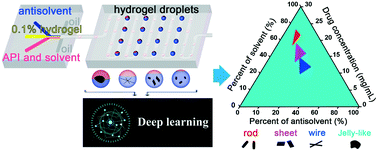A high-throughput system combining microfluidic hydrogel droplets with deep learning for screening the antisolvent-crystallization conditions of active pharmaceutical ingredients†
Abstract
Crystallization of active pharmaceutical ingredients (APIs) is a crucial process in the pharmaceutical industry due to its great impact in drug efficacy. However, conventional approaches for screening the optimal crystallization conditions of APIs are usually time-consuming, labor-intensive and expensive. Recently, droplet microfluidic technology has offered an alternative strategy for high-throughput screening of crystallization conditions. Despite its many advantages such as low sample consumption, reduced operation time, increased throughput, etc., some challenges remain to be solved, such as instability of droplets in the long-term and tedious efforts required for extracting useful information from massive data. To solve these problems, a high-throughput system that combined microfluidic hydrogel droplets with deep learning was proposed for the first time to screen the antisolvent-crystallization conditions of APIs. In this system, stable hydrogel droplets containing different concentrations of indomethacin, its solvent and antisolvent were generated on a chip. Crystals of indomethacin with different morphologies were formed in hydrogel droplets, and their optical images were captured by a camera. Then, deep learning was applied to identify the hundreds of indomethacin crystal images and successfully classify the crystal morphologies in a short time; a ternary phase diagram was drawn by combining the experimental results with the recognition results of crystal morphologies, and was used to guide the scale-up preparations of indomethacin crystals as desired. This system, which integrated high throughput preparation, characterization and data analysis, is also useful for screening the crystallization conditions and processes of semiconductors, catalysts, agrochemicals, proteins and other specialty chemicals.



 Please wait while we load your content...
Please wait while we load your content...